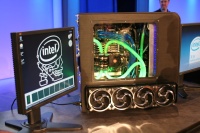Leaked - Skulltrail 8-core Penryn benchmarks at IDF


The Skulltrail is a computer based on a dual-socket motherboard that's probably a derivative of "Stoakley" which supports FSB1600 with Fully Buffered DDR2-800 DIMMS and two quad-core Penryn 45nm CPUs. The system shown below is based on two "pre-production" 3.4 GHz quad-core Penryn processors with two 2 GB DDR2-800 CL5 FBDIMMs. It also has two NVIDIA 8800GTX graphics cards in SLI configuration but the benchmarks in question weren't graphics intensive so they merely showcase the capability of the CPU.
I took a high-resolution photo of the benchmark results below [Update 1:30PM - converted to text below]
| Test system Configuration | System A | System B |
| PROCESSOR | 2x Pre-production 45nm Hi-k Intel quad core processors (12MB cache, 3.40Ghz, 1600MHz FSB) | Pro-production 45nmmi High-K quad core processor (12MB cache, 3.00GHz. 1333Mhz FSB) |
| MOTHERBOARD | Skulltrail dual socket motherboard | Pre-production Intel X38 - motherboard |
| BIOS | Pre-Production Engineering Bios | Pre-Production Engineering Bios |
| GRAPHICS CARD | 2 x NVIDIA GeForce 8800GTx | 1 x NVIDIA GeForce 8800GTX |
| GRAPHICS DRIVER | NVIDIA pre-production driver | NVIDIA ForceWare Release 162.22 |
| MEMORY | 2x2GB Pre-production Micron DRD2-800 CL5 FBDIMMs | 2x1GB Corsair CM3X 1024-1333C9DHX |
| HARD DRIVE | Seagate Barracuda 320GB 7200.10 7200RPM | Seagate Barracuda 320GB 7200.10 7200RPM |
| OPERATING SYSTEM | Vista x86 32-bit Ultimate | Vista x86 32-bit Ultimate |
| Benchmark or software application | ||
| 3DMark*06 V1.1.0 Pro - CPU (score) | 6359 | 4569 |
| 3DMark*06 V1.1.0 Pro - Overall (score) | 17006 | 11899 |
| Cinebench* R10 Beta (CPU Benchmark) | 21521 | 11810 |
| TMPG Inc. * TMPGEnc 4.0 Express rev 4.3.3.9999 Beta (seconds) | 53 | 72 |
I was in the demo booth for the SSE4 Penryn demos and Adobe Premier was also one of the applications being showcased with SSE4 support and it seemed to scale perfectly up to 4 threads but it wasn't demoed on Skulltrail which as 8 cores. I'm not sure how it compares to a pre-SSE4 processor but a beta version of DiVX was showing more than a doubling in performance per core at the same clock frequency compared with the existing Core 2 Duo 65nm processors.